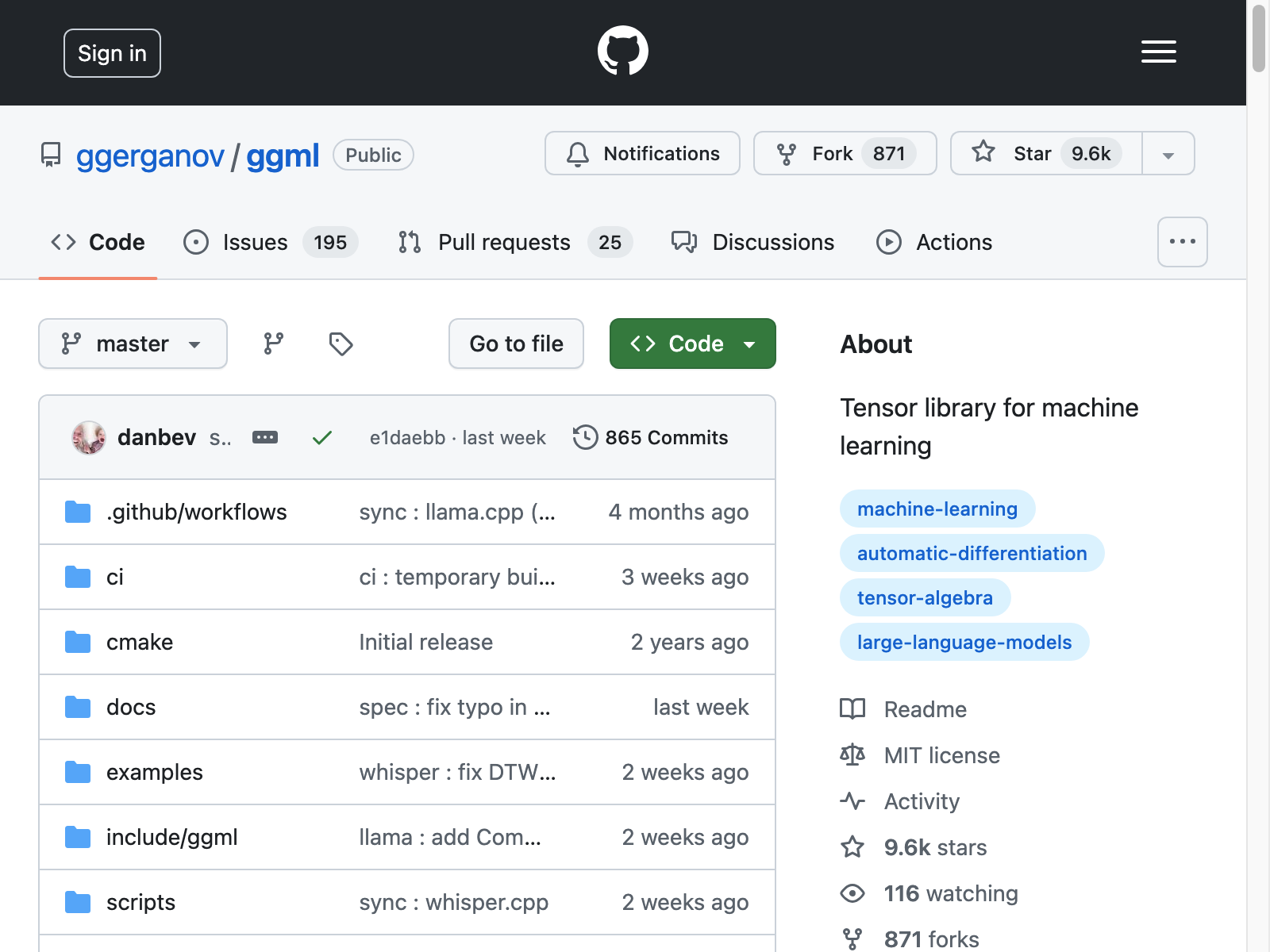Ggml: Tensor Library for Machine Learning

Ggml Overview
Ggml is an open-source tensor library designed to streamline machine learning projects. Developed by Georgi Gerganov, this lightweight and efficient tool offers a range of features that make it an attractive choice for developers and researchers working on AI-powered applications.
In our thorough review, we'll explore Ggml's key capabilities, discuss its use cases, and analyze its pros and cons, helping you determine if it's the right fit for your machine learning needs.
Ggml Key Features
-
Tensor Operations: Ggml provides a comprehensive set of tensor operations, including matrix multiplication, convolution, pooling, and more, allowing for efficient implementation of various neural network architectures.
-
Quantization Support: Ggml supports quantization of tensors, enabling reduced memory footprint and faster inference on resource-constrained devices, such as mobile phones and embedded systems.
-
Optimization Algorithms: The library includes popular optimization algorithms, such as Stochastic Gradient Descent (SGD) and Adam, making it easier to train machine learning models.
-
Cross-Platform Compatibility: Ggml is designed to be cross-platform, with support for Windows, macOS, and Linux, allowing developers to work seamlessly across different environments.
-
Easy Integration: Ggml is designed to be easily integrated into existing projects, with a simple and intuitive API that can be quickly understood and utilized by developers.
Ggml Use Cases
Ggml's versatility makes it applicable in a wide range of machine learning projects, including:
-
Natural Language Processing (NLP): Ggml can be used to build and deploy language models, such as transformers, for tasks like text classification, named entity recognition, and language generation.
-
Computer Vision: The library can be leveraged to develop and optimize computer vision models, such as convolutional neural networks, for image recognition, object detection, and segmentation tasks.
-
Edge Computing: Ggml's support for quantization and its small footprint make it an excellent choice for deploying machine learning models on edge devices, enabling real-time inference and on-device processing.
-
Research and Prototyping: Ggml's simplicity and flexibility make it a valuable tool for researchers and data scientists, allowing them to quickly experiment with new algorithms and architectures.
Ggml Pros and Cons
Pros:
- Efficient tensor operations for fast model inference
- Quantization support for reduced memory footprint
- Cross-platform compatibility for seamless development
- Easy integration with existing projects
- Open-source and actively maintained
Cons:
- Limited documentation and community support compared to larger frameworks
- Lacks some advanced features found in more comprehensive ML libraries
- May require more manual configuration and setup for complex models
Ggml Pricing
Ggml is an open-source project and is available for free. There are no subscription fees or licensing costs associated with using the library.
Ggml Alternatives
If you're looking for alternatives to Ggml, here are a few options to consider:
- TensorFlow: A widely-used, comprehensive open-source machine learning framework with a large community and extensive documentation.
- PyTorch: Another popular open-source machine learning library, known for its flexibility and ease of use, especially in research and prototyping.
- Keras: A high-level neural networks API that runs on top of TensorFlow, providing a simpler and more user-friendly interface for building and training models.
Ggml FAQ
Q: What is the primary purpose of Ggml? A: Ggml is a tensor library designed to simplify and streamline the development of machine learning models, with a focus on efficient tensor operations, quantization, and cross-platform compatibility.
Q: Is Ggml open-source? A: Yes, Ggml is an open-source project hosted on GitHub, allowing developers to contribute to its development and use it freely in their projects.
Q: Can Ggml be used for edge computing? A: Yes, Ggml's support for quantization and its small footprint make it well-suited for deploying machine learning models on edge devices, enabling real-time inference and on-device processing.
Q: What types of machine learning models can be built using Ggml? A: Ggml can be used to develop a wide range of machine learning models, including natural language processing (NLP) models, computer vision models, and more. Its versatility makes it applicable in various domains and use cases.
To learn more about Ggml and its capabilities, visit the project's official GitHub repository: https://github.com/ggerganov/ggml (opens in a new tab)